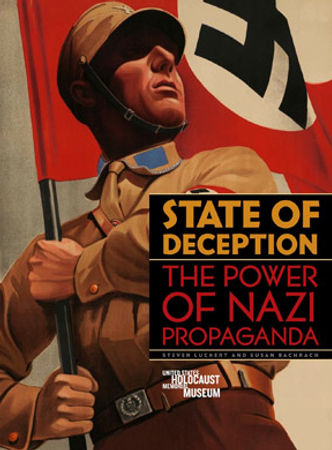Exhibit 2: Propaganda of the Nazi Party

Instructions:
Step 1: Read
Before looking at the images below, read the article about Nazi Propaganda by clicking on the link below: Nazi Propaganda
or copy and paste the following url:
https://encyclopedia.ushmm.org/content/en/article/nazi-propaganda
Step 2:
When you complete your reading, review the photographs of Nazi propaganda below. Pay close attention to common themes presented in the photos.
3. Finally, read the paragraphs titled, Nazi Propaganda and Censorship
4. Answer the questions in your Museum Response Guide below.









Nazi Propaganda and Censorship
Once they succeeded in ending democracy and turning Germany into a one-party dictatorship, the Nazis orchestrated a massive propaganda campaign to win the loyalty and cooperation of Germans. The Nazi Propaganda Ministry, directed by Dr. Joseph Goebbels, took control of all forms of communication in Germany: newspapers, magazines, books, public meetings, and rallies, art, music, movies, and radio. Viewpoints in any way threatening to Nazi beliefs or to the regime were censored or eliminated from all media. During the spring of 1933, Nazi student organizations, professors, and librarians made up long lists of books they thought should not be read by Germans. Then, on the night of May 10, 1933, Nazis raided libraries and bookstores across Germany. They marched by torchlight in nighttime parades, sang chants, and threw books into huge bonfires. On that night more than 25,000 books were burned. Some were works of Jewish writers, including Albert Einstein and Sigmund Freud. Most of the books were by non-Jewish writers, including such famous Americans as Jack London, Ernest Hemingway, and Sinclair Lewis, whose ideas the Nazis viewed as different from their own and therefore not to be read.
The Nazi censors also burned the books of Helen Keller, who had overcome her deafness and blindness to become a respected writer; told of the book burnings, she responded: "Tyranny cannot defeat the power of ideas." Hundreds of thousands of people in the United States protested the book burnings, a clear violation of freedom of speech, in public rallies in New York, Philadelphia, Chicago, and St. Louis.
Schools also played an important role in spreading Nazi ideas. While some books were removed from classrooms by censors, other textbooks, newly written, were brought in to teach students blind obedience to the party, love for Hitler, and anti-Semitism. After-school meetings of the Hitler Youth and the League of German Girls trained children to be faithful to the Nazi party. In school and out, young people celebrated such occasions as Adolf Hitler's birthday and the anniversary of his taking power.